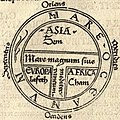Hamitic
Hamitic is an outdated theory that claims that the so-called Hamitic race is superior to the negroid races of African. John Hanning Speke started the theory. Karl Richard Lepsius and Carl Meinhof extended the theory by using languages to divide people into Hamitic or non-Hamitic. That categorization is no longer in use.
Alternative theories
Another way to classify people into Hamitic or non-Hamitic is by ethnic roots. Negroid people were perceived as Shemetic,[clarification needed] as opposed to the Hamitic Ethiopian, Sudanese, and some other West African ethnic groups as attested by the genealogy of ancient ethnic lineages. For instance, a person who has ancestry from Rome would be considered closer to a Hamite than a person whose ancestry is in Africa.
Ironically, the Hamites include some of the darkest Sub-Saharan African groups like the Nilotes, who were considered closest to Europeans, as opposed to the Chadic Sub-Saharan Africans, who share a common RB1 lineage.[clarification needed]
The Hamitic theory also was one factor in classifying the negroid races of Africa upon colonization. That was one factor leading to the Rwandan genocide, which pitted the Tutsis against the Hutus despite their strong similarities and long co-existence.
Hamitic Media
German 1932 ethnographic map portraying Hamites (in German: "Hamiten") as a subdivision of the Caucasian race ("Kaukasische Rasse"). (Meyers Blitz-Lexikon).
Geographic identifications of Flavius Josephus, c. 100 AD; Japheth's sons shown in red, Ham's sons in blue, Shem's sons in green.
This T and O map, from the first printed version of Isidore's Etymologiae, identifies the three known continents as populated by descendants of Sem (Shem), Iafeth (Japheth) and Cham (Ham).
Languages of pastoralist Bedouins such as the Beja were the model for the conflation of ethnic and linguistic evidence in the construction of Hamitic identity.
Egyptian woman with ovoid facial profile, from Giuseppe Sergi's The Mediterranean Race (1901).





